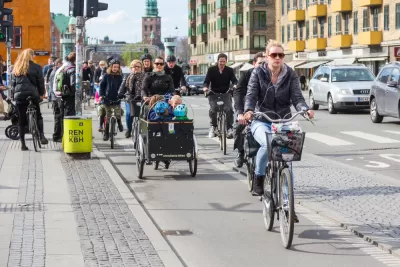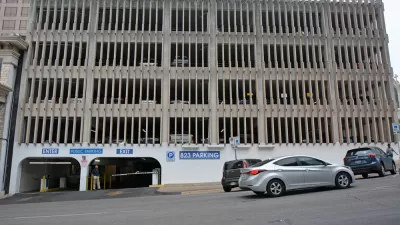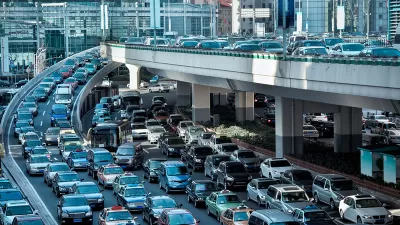Electric vehicles can help reduce greenhouse gas emissions, but not enough to prevent the worst of climate change and not as much as walkable cities with far fewer cars on the road.

The Inflation Reduction Act (IRA) commits the United States to an unprecedented investment in climate action—going well beyond previous efforts from the Obama and Biden administrations, such as the previous clean energy and transportation infrastructure investments included in the American Recovery and Reinvestment Act and the Infrastructure Investment and Jobs Act, respectively.
Those previous examples could also serve as cautionary tales—of incremental steps that failed to solve greenhouse gas emissions while reinforcing some of the systems that have contributed to the climate crisis. All of those efforts have yet to balance the carbon budget yet—will the IRA?
A recent analysis by Yonah Freemark for the Urban Institute identifies cause for concern about the inadequacies of the IRA, noting that while the bill will make significant progress toward the goals set by the Paris Climate Agreement, the bill’s approach to transportation infrastructure, especially its reliance on electric cars, will prove inadequate for the needs of the climate.
“Focusing on electric cars and trucks is unlikely to quickly reduce US emissions and fails to account for the resource intensity of car manufacturing, noncarbon pollution produced by vehicles, and the unsustainable land uses car dependence produces,” writes Freemark.
The first problem is one of affordability, which will make it hard to scale the electric vehicle market commensurate with the need.
Proponents contend the IRA’s consumer tax credits for new electric vehicles could accelerate vehicular fleet electrification. But eligibility requirements are narrow, and most electric cars don’t qualify (the credits cap vehicle costs; require domestic assembly, domestic batteries, and/or battery minerals from certain countries; and exclude high-income purchasers). Electric cars are also more expensive than gas-powered ones, and though some estimates (PDF) project considerable transportation emissions reductions with the IRA, others model just 1–2 percent reductions this decade, in part because even with the vehicle credits, fewer than 20 percent of all vehicles will be zero-emission by 2030.
But there is also a critical angle of direct relevance to land use planning and urban design. The IRA’s reliance on electric cars doesn’t prioritize the more climate friendly approach of getting people out of their cars—on foot, onto bikes, or onto transit.
Freemark also notes that a future of automobile dependency also locks in other negative externalities, such as traffic fatalities, congestion, and air and water pollution. For more on the various negative externalities of electric vehicles, and the need to set a price for their use, with new fees and taxes, see a recent feature Planetizen feature article by Adam Millard-Ball and Michael Manville.
FULL STORY: What the Inflation Reduction Act Did, and Didn’t Do, for Sustainable Transportation

Planetizen Federal Action Tracker
A weekly monitor of how Trump’s orders and actions are impacting planners and planning in America.

DARTSpace Platform Streamlines Dallas TOD Application Process
The Dallas transit agency hopes a shorter permitting timeline will boost transit-oriented development around rail stations.

Congressman Proposes Bill to Rename DC Metro “Trump Train”
The Make Autorail Great Again Act would withhold federal funding to the system until the Washington Metropolitan Area Transit Authority (WMATA), rebrands as the Washington Metropolitan Authority for Greater Access (WMAGA).

Supreme Court Ruling in Pipeline Case Guts Federal Environmental Law
The decision limits the scope of a federal law that mandates extensive environmental impact reviews of energy, infrastructure, and transportation projects.

Texas State Bills to Defund Dallas Transit Die
DART would have seen a 30% service cut, $230M annual losses had the bills survived.

Bikeshare for the Win: Team Pedals to London Cricket Match, Beats Rivals Stuck in Traffic
While their opponents sat in gridlock, England's national cricket team hopped Lime bikes, riding to a 3-0 victory.
Urban Design for Planners 1: Software Tools
This six-course series explores essential urban design concepts using open source software and equips planners with the tools they need to participate fully in the urban design process.
Planning for Universal Design
Learn the tools for implementing Universal Design in planning regulations.
Roanoke Valley-Alleghany Regional Commission
City of Mt Shasta
City of Camden Redevelopment Agency
City of Astoria
Transportation Research & Education Center (TREC) at Portland State University
US High Speed Rail Association
City of Camden Redevelopment Agency
Municipality of Princeton (NJ)





























